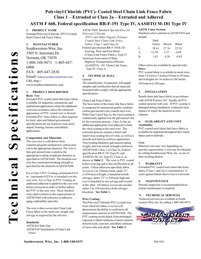The Reliable Fence Standard
For Decades
From a basic 4′ residential job to a maximum security prison, chain-link fencing is one of the most versatile products sold. Privacy screens and privacy slats are just a few of the many options available in customizing your chain-link fence. Let a professional help you with your next chain-link fence project by contacting a Capitol sales representative.
Product Guide
Chain-Link
Often associated with security, chain-link fences are a versatile choice with many uses.
Decorative
Vinyl color-coated options can make chain-link fence practically blend into the landscape around it. Black, green, and brown are most often used to minimize the presence of the fence.
Recreational
Used in parks, sports facilities, swimming pools, and other areas, chain-link fences are also used for temporary structures during special events like parades.
Residential
Chain-link is both an economical and secure way to protect children and pets. It provides security while allowing homeowners to see through it. Slats can also be inserted for additional security and privacy. Gates in single walk and double drive styles are often used with chain-link.
Commercial & Industrial
Industrial chain-link is the number one way to provide a safe and secure work environment, with traditional metallic being a popular choice. Chain-link fence is an economical option in establishing security perimeters or enclosing hazardous areas from the public. Several types of sliding gates are available for commercial and high-security applications.
Pool Fencing
The open weave of chain-link allows a see-through protective barrier for adults to monitor the activity around the pool area.
Learn More
Chain-Link Details
Specifications
Additional Requirements
Questions
Framework
Specifications
The American Society for Testing and Materials recommends the following minimum standards for producing chain-link fencing:
- A392-96 – Specs for Zinc-Coated Steel Chain-Link Fabric Fence
- A491-96 – Specs for Aluminum-Coated Steel Chain-Link Fence Fabric
- F552-94 – Terminology Relating to Chain-Link Fencing
- F567-00 – Practice for Chain-Link Fence Installation
- F626-96a – Specs for Fence Fittings
- F668-99a – Specs for PVC-Coated Steel Chain-Link Fence Fabric
- F934-96 – Specs for Standard Colors for Polymer-Coated Chain-Link Materials
- F1043-00 – Specs for Pipe, Steel, Hot-Dipped Zinc-Coated (Galvanized) Welded, for Fence Structures
- F1183-96 – Specs for Aluminum Alloy Chain-Link Fence Fabric
- F1553-96 – Guide for Specifying Chain-Link Fence
- F1664-95 – Specs for PVC-Coated Steel Tension Wire used w/ Chain-Link Fence
- F1665-95 – Specs for PVC-Coated Steel Barbed Wire used w/ Chain-Link Fence
- F1908-98 – Guides for Fences for Residential Outdoor Swimming Pools, Hot Tubs, and Spas
Additional Requirements
A popular choice, chain-link fences must still meet a series of requirements.
- The Chain-Link Fence Manufacturers Institute advises that the typical residential chain-link fence should be strong enough for a 200-pound man to climb over while both the framework and fabric maintain structural integrity.
- The gauge and wall thickness of the top rail, line rails, corner posts, and the gauge of the mesh fabric are all critical to the strength and long term durability of a quality chain-link fence.
- Fence specifications can be based on the height of the fence and desired strength: light, medium, or heavy-duty construction. Chain-link fence is simply a woven steel wire fence coated with zinc to prevent rust, otherwise known as galvanized fence. Color chain-link fence is coated with zinc, and then covered with a vinyl polymer coating that helps prevent rust and adds color.
- Chain-link fabric comes in a variety of gauges, which is the diameter of the wire. The higher the gauge number, the smaller the wire diameter. 6 gauge = .192 inches, 9 gauge = .148 inches, 11 gauge = .120 inches, 11.5 gauge = .113 inches, 12 gauge = .106 inches, 12.5 gauge = .099 inches
- Mesh size is the distance between two parallel wires in the fabric. Common mesh sizes are approximately two inches, while smaller mesh sizes are often used for added safety and security.
- Chain-link fabric is available in a variety of heights, from three feet to twelve feet.
Questions
When specifying a chain-link fence, the American Fence Association recommends that all architects, engineers, and specifiers consider the following variables:
- Mesh size – the size of the diamond, measuring from one side to the other
- Fabric gauge – the smaller the number, the thicker the wire used in weaving needs to be
- Top rail – supports fence fabric between line posts and corner posts
- Line post – general on 10 foot centers to support the top rail
AFA recommends that local building codes should always be consulted for the minimum fencing requirements in that area.
Framework


- PVC Fabric
- Class 1 Extruded
- ASTM F 668
- Federal specification RR-F-191 Type IV
- AASHTO M-181 Type IV

- PVC Fabric
- Class 1 - Extruded or Class 2a - Extruded or Adhered
- ASTM F 668
- Federal specification RR-F-191 Type IV
- AASHTO M-181 Type IV

- PVC Fabric
- Class 2b
- ASTM F 668
- Federal specification RR-F-191 Type IV
- AASHTO M-181 Type IV, Class B



